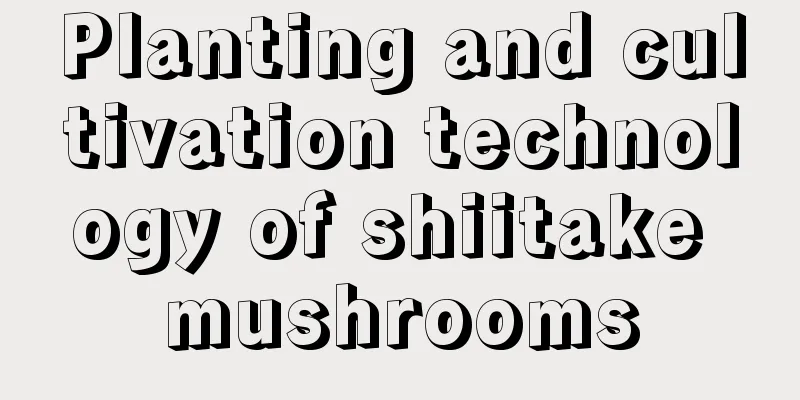Planting and cultivation technology of shiitake mushrooms

|
As an edible fungus, the cultivation of shiitake mushrooms must first start with the preparation of the strains. After determining the appropriate planting season, the next step is to select and prepare the culture medium. After the culture medium has been fermented, it can be put into bags and inoculated with holes. Let’s learn about the planting and cultivation techniques of shiitake mushrooms. 1. Preliminary preparation Site selection and ridge cultivation: Choose mountain fields with good ecological environment, fresh air, pure water and no pollution sources. It is best to have an east-west orientation, flat terrain, easy drainage and irrigation, and convenient transportation. Avoid sites that are susceptible to hail and flooding. Choose the appropriate ridge cultivation method according to the terrain. Low ridges should be made on high terrain or sloping land, while flat ridges or high ridges should be made on low-lying land. Mushroom bag production: Formula 1: 79% poplar sawdust, 20% wheat bran, 1% gypsum, 0.1% carbendazim (50% wettable powder ). Recipe 2: 45% corn cobs (crushed to the size of broad beans), 40% poplar sawdust, 13% cornmeal , 1% gypsum, 1% lime powder, 0.1% carbendazim (50% wettable powder). Make sure the sawdust is aged for more than half a year and the wheat bran is fresh and free of mold. Mixing materials: Mix sawdust, wheat bran and gypsum, stir 4-5 times, spray carbendazim and lime water into the dry material, and add water to the moisture content of about 60%. Bagging: Use polyethylene film, large bag 25×55 cm, medium bag 17-20×55 cm. When bagging, ensure that there is no air leakage and the bag is moderately tight. 2. Sterilization Earthen steamer production: Use a 1.5-meter diameter iron pot with an inner diameter of 2×2×2.5 meters and a volume of 8-10 cubic meters. Add water to the pot until the curtain is 20 cm high, cover the curtain with sack, and make the pot cover with 1.5 mm galvanized sheet . Add water and fill the pot: Add water to the pot, place the material bags neatly, and proceed in batches. Sterilization process: Heat to 100℃ over high heat, maintain for 10 hours, simmer overnight, remove from heat when material temperature drops to 70℃, and cool rapidly. 3. Vaccination Disinfection: Tools should be sealed and disinfected 4 days in advance, using sulfur fumigation. Inoculation time: When the temperature of the bag drops to 30℃, preferably in the morning or evening. Inoculation process: 4 people are responsible for drilling holes, taking out the fungus, mixing bags, tying the bags, and stacking. Fungal culture: dim light, room temperature 25℃, puncture holes after 16-20 days, gradually deepening the holes. 4. Mushroom production management Inducing mushroom growth: Stop watering for 4-5 days after the color change period, and alternate between dry and wet conditions to induce mushroom growth. Early management: From May to early June, strengthen ventilation, prevent rain, and reduce humidity. Mid-term management: From late May to late July, lower the temperature to promote fruiting body growth. Post-management: From late August to the end of September, prevent tube rot and mushroom rot. 5. Remove the bag and change the color and cover the soil Removing bags: After 90-110 days, cut the bags open with a blade and spread them flat on the bed surface. Mushroom bed disinfection: spray bleach or lime water, spray copper sulfate. Color change: Remove the film after 3 days, ventilate, rinse, and maintain 18-22℃. Covering soil: Use topsoil, mix in lime powder or burnt soil, and cover the mushroom tube. 6. Management during the fruiting period Mushroom shed: Use existing shed or build a new one, facing sunny and sheltered from wind, in dry terrain. Mushroom bag arrangement: horizontal row, bag spacing 4 cm, 42-44 bags per layer. Variable temperature mushroom cultivation: the temperature difference between day and night is more than 10℃, and the humidity is maintained at 85%. 7. Harvest Remove the inferior and keep the good: thin out the mushrooms appropriately and keep a uniform distance. Harvesting: Sell fresh or make into dried products. After harvesting, let the mushroom tubes rest and grow fungi. The above is an introduction to the key points of shiitake mushroom cultivation. If you want to grow shiitake mushrooms, you must first have a suitable cultivation area.
|
<<: How to sow peach blossoms?
>>: When can peach blossom cuttings take root? Can peach blossoms be propagated by cuttings?
Recommend
Cultivation methods and precautions of the nine-death grass
The plant of the herb is very easy to grow and ha...
Disease control of Alpinia serrulata
Common diseases of Alpinia serrulata Leaf blight ...
How to water cymbidium
1. First of all, you need to choose a clay flower...
Why apply fertilizer? Just throw these garbage into the pots and the flowers will grow wildly like they were injected with chicken blood!
Apple peel Apple is a fruit that can be eaten all...
Can I grow tuberose at home?
Can I grow tuberose at home? Although tuberose ha...
What to do if the leaves of the swallowtail palm become soft
The reason why the leaves of the swallowtail palm...
How to grow small-leaf red sandalwood trees more luxuriantly
Growth conditions of red sandalwood The small-lea...
How to trim the cheeky skin
When to trim the cheeky skin The thick-skinned pl...
What fertilizer is best for sunflower topdressing (what fertilizer does sunflower need to be flushed for absorption in the early stage)
Sunflower topdressing fertilizer time First of al...
Is it okay to add vinegar to jasmine leaves when they turn yellow?
1. Reasons There are many reasons why jasmine lea...
Is Black Mage expensive?
Price by region The price of Black Mage is differ...
Do flowers attract mosquitoes? Add some of this and mosquitoes will run away when they smell it!
Spray some mint water and all the aphids will die...
Causes and treatments of yellow cherry leaves
1. Fertilizer damage Reason: When the concentrati...
Flower fertilizer is not as good as this kind of "waste material". One watering is enough to make the "plants" grow vigorously!
When it comes to fertilizing flower plants, the f...
Where are water chestnuts produced in abundance?
Water chestnut is a plant widely distributed in w...









